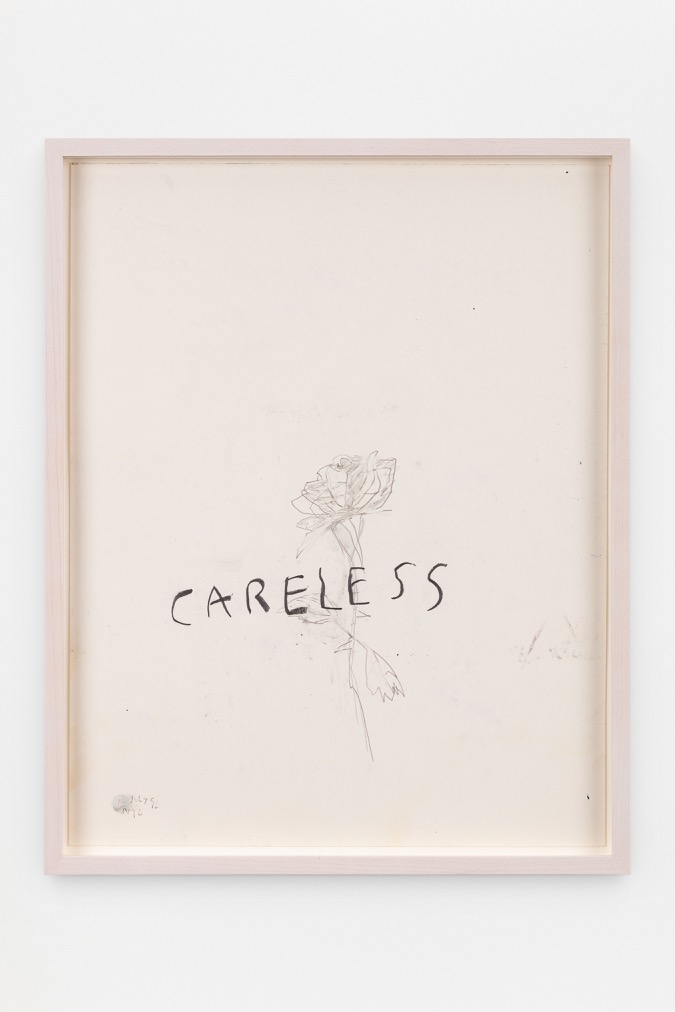
Jack Pierson
Careless, 1992 July 10, NY
1992
Graphite on paper
Framed Dimensions: 15 x 12 x 1 1/4 inches (38.1 x 30.5 x 3.2 cm)
Paper Dimensions:11 x 14 inches (27.9 x 35.6 cm)
Image courtesy of the artist and Regen Projects, Los Angeles
Using language as a material and subject, this work on paper by Jack Pierson (b. 1960, Plymouth) is part of a series of early word drawings “about loss and longing” that is representative of the way Pierson “balances irony and pathos to keep both viable.”
Pierson captures the intensity of [drawing’s]’s junior-high models, at once desperate to express deep feelings to an uncaring world and urgently disguising its messages as art. Pierson’s pop cabalism extracts intimate and powerful connotations from found bits of tackiness, transforming them into expressions of shrewdly observed, vivid feeling.
– Tom Briedenbach, “Jack Pierson, American Fine Arts,” Artforum, October 1998
[U]nless contemplation, dreaming, reading, cruising, talking, and singing to oneself or not; unless someone alone remembering something to believe in—a big blue beyond, God perhaps—remembering because someone else can’t anymore or won’t, remembering for them; unless these are suddenly all abject affairs, then Pierson’s is not a pathetic esthetic. There is mourning and there is morning. He finds the business of beauty always going on in the midst of mess, finds the mess in the midst of beauty—oh, Elizabeth Taylor in The Only Game in Town, squeaking like an overgrown Chihuahua to Warren Beatty, ‘I. Love. You. God. Damn. It.'”
– Bruce Hainley, “Jack Pierson, Luhring Augustine,” Artforum, September 1994
Similarly employing self-portraiture or personal narrative “as a means of departure toward worlds of social relations, homoerotic love among them,” photography of male subjects and sculptural word pieces made of found marquis letters form two other major bodies of work in Pierson’s practice.
Pierson first attracted attention in the early ’90s, the moment of “slacker” and “loser” art. Disparate practices seemed unified as a sort of acid-reflux response to the vanished go-go excesses of the ’80s art world. Rather than fashioning pristine, closed-circuit, autocritical artworks, Cady Noland, Karen Kilimnik, Cary S. Leibowitz/Candyass, Sean Landers, and others created pieces that indulged an apparent squalor, collecting the detritus of personal histories and popular culture and serving up “trash.”
– David Rimanelli, “Jack Pierson, Regrets at the New Museum,” Artforum, November 2002
In this recycling of the”detritus of personal histories and popular culture,” Pierson’s practice can be linked to that of other artists in the collection such as Ser Serpas, Julien Ceccaldi, Vaginal Davis, Thomas Lanigan-Schmidt, Paul Thek, and Danny McDonald. Pierson showed with American Fine Arts in the early 1990s when he met Tom Burr, with whom he recently presented an exhibition.
Provenance
Regen Projects
See also
Jack Pierson in the collection of the MCA, Chicago
Jack Pierson in the collection of the MoMA
Jack Pierson at Regen Projects
“Jack Pierson,” Regen Projects, Los Angeles, 29 September – 29 October 1994
“Jack Pierson,” Regen Projects, Los Angeles, 13 November – 11 December 1996
“Jack Pierson,” Regen Projects, Los Angeles, 17 October – 28 November 1998
Lisa Pasquariello, “Jack Pierson, Cheim & Read,” Artforum Summer 2006
“Tom Burr-Jack Pierson,” Galerie Neu, Berlin, 1 December 2006 – 28 February 2007
Heike Föll, “Tom Burr – Jack Pierson,” Artforum Critic’s Picks, December 13, 2006